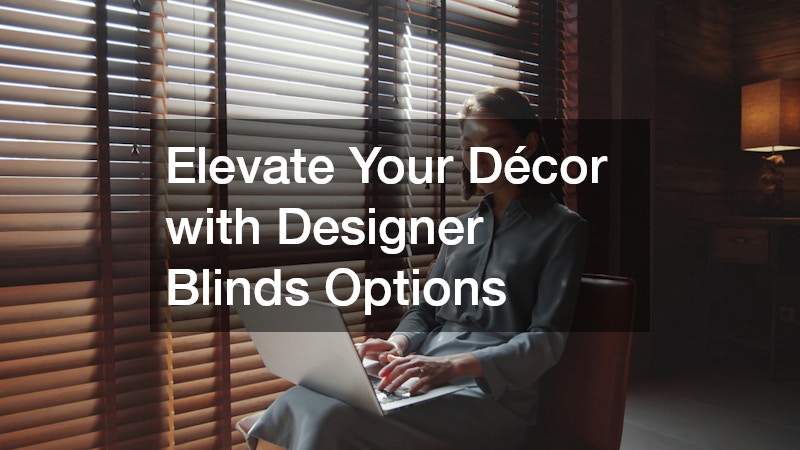Creating a visually cohesive and inviting interior space requires more than just selecting the right furniture or wall colours. It often comes down to the finer details—those finishing touches that bring a room to life. Among these, window treatments stand out as both functional and aesthetic enhancements. Designer blinds offer a sophisticated way to frame your windows while significantly elevating your home décor. With a vast array of materials, colours and styles available today, the modern homeowner can find blinds that perfectly align with their personal taste and design objectives.
From minimalist interiors to more classic or eclectic arrangements, the right blinds serve not only to filter light but to enhance the character and mood of a room.
Why Designer Blinds Are Worth the Investment
Choosing designer blinds is an investment in style and comfort. While traditional curtains have long been a go-to option, blinds bring a more contemporary edge to interior design. Their clean lines, adjustable light control and versatile appearance make them particularly appealing for homeowners seeking a blend of practicality and elegance. With advances in materials and mechanisms, today’s blinds are also more durable and easy to maintain than ever before. Whether your goal is to control privacy, regulate indoor temperature or simply add a unique design feature, custom blinds options provide an ideal solution.
Enhancing Architectural Features with Blinds
One of the most compelling reasons to consider designer blinds is their ability to complement and enhance a room’s architectural features. Floor-to-ceiling windows, bay alcoves or high-set clerestory openings all benefit from thoughtfully selected blinds. They can soften harsh daylight, draw attention to structural details or add layers of visual interest through texture and tone. For example, Roman blinds in a natural linen fabric can introduce a tactile warmth to an otherwise stark living room, while sleek aluminium venetians can offer a striking contrast in a modern, industrial-inspired kitchen. This interplay of materials and design makes blinds a powerful tool for transforming interiors.
Tailored Options for Unique Spaces
Another key advantage of designer blinds lies in their customisability. Off-the-shelf solutions rarely achieve the same tailored effect that professionally made and installed blinds do. By working with a designer or specialised supplier, homeowners can choose from a range of fabrics, finishes and operating systems. Motorised blinds, for instance, allow for seamless integration with smart home systems, providing effortless control with a simple remote or app. This not only boosts convenience but also enhances safety—particularly in homes with children or pets where cord-free systems are preferred. The ability to personalise these elements means your blinds become an integral part of your home’s identity, rather than an afterthought.
Improving Energy Efficiency with Blinds
In addition to aesthetics and convenience, designer blinds also contribute to improved energy efficiency. During Australia’s warm summer months, sunlight can rapidly heat indoor spaces, driving up air conditioning costs. Conversely, in cooler seasons, poorly insulated windows can lead to heat loss. Quality blinds act as an insulating layer, helping to regulate indoor temperatures and reduce energy consumption. Cellular or honeycomb blinds, in particular, are renowned for their thermal properties. When selected carefully, these blinds do more than look good—they help make your home more sustainable and comfortable year-round.
Sound Control for a Quieter Home
Acoustic control is another often-overlooked benefit of blinds, especially in urban or high-traffic areas. Certain fabrics and designs can absorb sound and reduce echo within a space. This makes them particularly useful in home offices, media rooms or bedrooms where peace and quiet are paramount. Combined with other soft furnishings, blinds can significantly improve the acoustic performance of a space without compromising on design.
Layering for Style and Function
The ability to layer blinds with other window treatments further broadens their appeal. Pairing roller blinds with sheer curtains, for instance, allows for both daytime light filtration and night-time privacy. Layering also adds depth and dimension to your window areas, making them a visual focal point. Designers often use this technique to introduce contrast in colour or texture, enhancing the overall style narrative of a room. Whether your décor leans toward coastal, Scandinavian or bohemian themes, layering blinds with complementary elements ensures cohesion and flair.
Light Control and Room Orientation
Choosing the right blinds also means understanding how light interacts with your space. North-facing rooms receive abundant natural light, which can be softened with sheer or translucent options. In contrast, rooms with less natural light might benefit from lighter-coloured blinds that reflect rather than absorb light. The orientation of your windows, your room’s purpose and the mood you wish to create should all influence your selection. For instance, blockout blinds may be ideal in a bedroom where total darkness is needed, while translucent blinds could be perfect for a sunroom that thrives on brightness and warmth.
Style, Comfort and Lasting Value
In conclusion, elevating your décor with designer blinds options is a decision that offers lasting value. From enhancing visual appeal and improving energy efficiency to providing privacy and acoustic comfort, blinds are an essential component of modern interior design. Whether you’re renovating a single room or redesigning your entire home, investing in high-quality blinds ensures that every window tells a story of style and sophistication.
.




